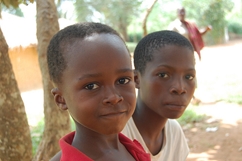
Millions of children around the world live in areas torn apart by armed conflict. These children often face very difficult choices and may suffer from malnutrition, poverty and confront multiple forms of violence. However, these children are also resilient and given the opportunity, they can become agents of peace in their communities. The Canadian Red Cross, alongside its sister Red Cross and Red Crescent National Societies, seeks to improve the lives of children affected by armed conflict. However, many obstacles present in conflict zones prevent the Movement from reaching out to children in need.
Children in conflict zones are susceptible to more than just the dangers of poverty and starvation - they are frequently targets for armed groups seeking to use them as child soldiers.
An estimated 300,000 child soldiers are currently active in more than 30 countries and are serving with hostile paramilitary and opposition forces. For many, personal choice was not a factor in the decision.
Children are voluntarily recruited, coerced or forced into joining government, opposition and paramilitary forces. Recruitment methods for child soldiers can be cruel - the result of threats or direct intimidation. Child soldiers may be forced to witness and commit grave atrocities, while others may be grateful for protection and access to food and shelter in difficult times. These experiences can severely alter the mental health of a young person, increasing their vulnerability.
When it comes to child soldiers, international humanitarian law has sought to intervene by limiting the age at which a child may be recruited or used in some way for fighting. Beginning with the 1977 Additional Protocols to the Geneva Conventions that banned children under the age of 15 from fighting, subsequent measures like the 1989 Convention on the Rights of the Child and the 2000 Optional Protocol to the Convention on the Rights of the Child placed higher age limits on recruitment.
In addition to prohibiting the use or recruitment of child soldiers, international humanitarian law offers other protections to children, including necessitating access to medical care, exemption from the death penalty, captivity and separation from their families, as well as to guaranteeing the right to food, water, shelter and other basic essentials.
The Canadian Red Cross is devoted to helping children in war-ravaged areas find safety and opportunities for rehabilitation, to heal from the effects of armed conflict. The Children and War toolkit is designed to get Canadians engaged on the issue of children and war by giving you an overview of the realities faced by children in conflict zones around the world.
To learn more about how you can get involved, please visit the website or your local Red Cross office.